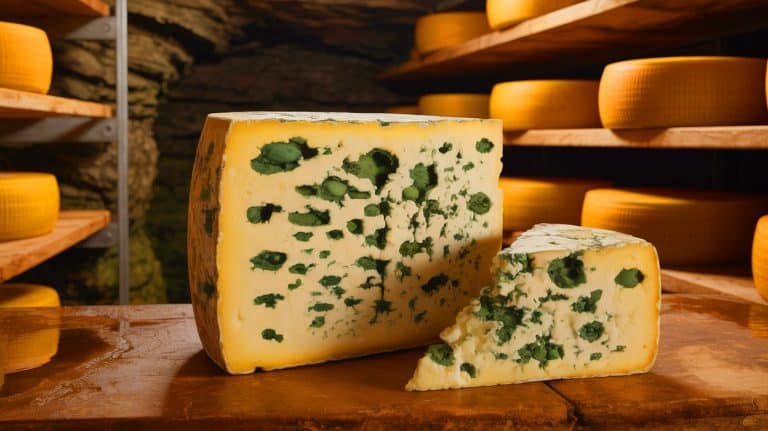| IN A NUTSHELL |
|
In an unexpected turn of events, scientists have stumbled upon a fascinating instance of evolution in real-time, right in the heart of a Vermont cheese cave. This accidental discovery by researchers at Tufts University provides a rare look at how microorganisms adapt in specific environments. The study focused on Bayley Hazen Blue cheese, produced at Jasper Hill Farm, and revealed significant evolutionary changes within the mold responsible for its characteristic rind. This finding not only offers insights into microbial evolution but also holds potential implications for human health, food security, and culinary innovation.
The Accidental Discovery
The story begins in 2016 when Benjamin Wolfe, a biology professor at Tufts University, stored a sample of Bayley Hazen Blue cheese in his lab freezer. Years later, a graduate student collected fresh samples from the farm’s cheese-aging caves and brought them back to the lab. It was then that Wolfe noticed a stark change in the mold’s appearance. The typically green mold, known as Penicillium solitum, had turned chalk-white. This observation sparked a new research project, aiming to understand the genetic mechanisms behind this color transformation.
Upon further investigation, the team discovered that the shift in coloration was due to alterations in a gene called alb1, responsible for melanin production. Melanin serves as a protective barrier against UV radiation, but in the dark, damp environment of a cheese cave, it becomes unnecessary. The evolutionary process known as “relaxed selection” enabled the fungi to save energy by eliminating melanin production, thereby gaining a competitive growth advantage. This phenomenon, where organisms adapt to conditions with fewer stressors, is exemplified by the Mexican cavefish, which lost its eyesight to prioritize other senses.
Understanding Microbial Evolution
Microbial evolution is not new; however, observing it in a specific location over a short period is exceedingly rare. In this case, the fungi colonies displayed varied mutations, including point mutations and insertions from transposable elements, or “jumping genes.” These genetic changes disabled the alb1 gene, halting melanin synthesis and resulting in the white mold. Remarkably, this genetic adaptation allowed the mold to thrive, growing faster and dominating the cheese cave environment.
The implications of this discovery extend beyond cheese. By studying how Penicillium adapts in cheese caves, researchers can gain insights into how related fungi, such as Aspergillus, adapt in human lungs. Some strains of Aspergillus can cause serious health issues, including invasive pulmonary aspergillosis. Understanding the genetic drivers behind these adaptations could lead to new treatments and preventive measures for such conditions.
Implications for Food Security and Flavor Innovation
The discovery of this evolutionary process has significant implications for food security. Fungi are responsible for destroying approximately 40% of global crops, making them a considerable threat to agriculture. By understanding how quickly molds adapt to new environments, scientists can develop strategies to combat spoilage, especially during storage and transport. Identifying the genetic factors driving these adaptations could be crucial in designing effective solutions.
Moreover, the research opens up exciting possibilities for culinary innovation. When the newly evolved white-strain fungus was used to inoculate brie, it produced a rind with a nuttier, less funky flavor. This finding suggests that food scientists could potentially harness these evolutionary changes to create new and desirable cheese flavors. It demonstrates how studying natural processes can lead to unexpected and beneficial culinary advancements.
The Role of Serendipity in Scientific Breakthroughs
This discovery highlights the significant role of chance in scientific breakthroughs. Many pivotal advances have been the result of serendipitous findings. For instance, the discovery of penicillin by Alexander Fleming occurred when he noticed mold killing bacteria in a Petri dish. Similarly, the development of rapamycin, a critical component in geroscience, originated from a soil sample collected on Easter Island. Such examples underscore the value of preserving unexpected findings, as they often pave the way for groundbreaking science.
The Vermont cheese cave study, published in Current Biology, is another testament to how nature can surprise and teach us. By observing evolution in action, scientists are reminded of the complexity and adaptability of life, inspiring future research and innovation.
As researchers continue to explore the evolutionary changes in Penicillium and other microorganisms, the potential applications in medicine, agriculture, and gastronomy appear promising. This discovery raises intriguing questions about the future of microbial research: How might these findings influence the development of new treatments or food products? What other evolutionary phenomena are hiding in plain sight, waiting to be uncovered?
Did you like it? 4.7/5 (20)






